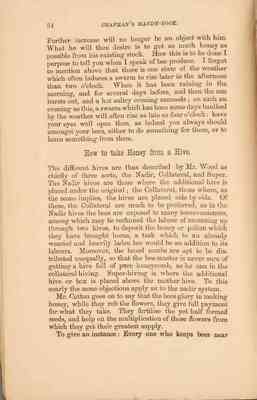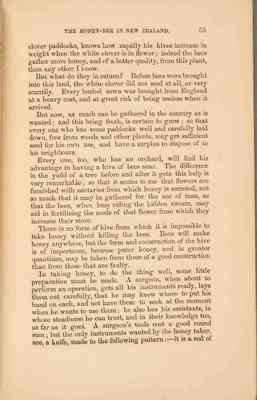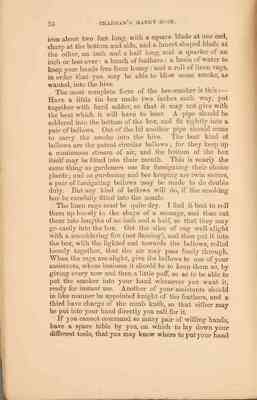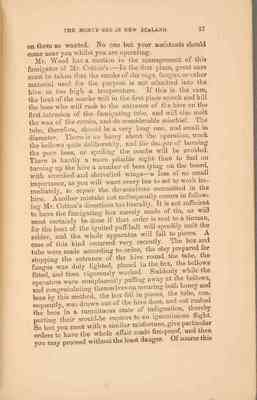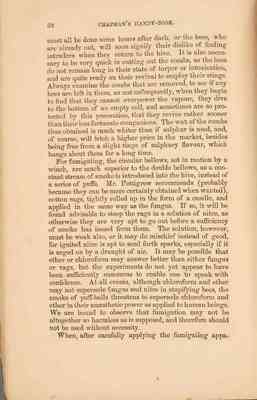Pages
34 CHAPMAN'S HANDY-BOOK.
Further increase will no longer be an object with him. What he will then desire is to get as much honey as possible from his existing stock. How this is to be done I purpose to tell you when I speak of bee produce. I forgot to mention above that there is one state of the weather which often induces a swarm to rise later in the afternoon than two o'clock. When it has been raining in the morning, and for several days before, and then the sun bursts out, and a hot sultry evening succeeds; on such an evening as this, a swarm which has some days baulked by the weather will often rise as late as four o'clock: have your eyes well open then, as indeed you always should amongst your bees, either to do something for them, or to learn something from them.
How to take Honey from a Hive.
The different hives are thus described by Mr. Wood as chiefly of three sorts, The Nadir, Collateral, and Super. The Nadir hives are those where the additional hive is placed under the original; the Collateral, those where, as the name implies, the hives are placed side by side. Of these, the Collateral are much to be preferred, as in the Nadir hives the bees are exposed to many inconveniences, among which may be reckoned the labour of mounting up through two hives, to deposit the honey or pollen which they have brought home, a task which to an already wearied and heavily laden bee would be an addition to its labours. Moreover, the brood combs are apt to be distributed unequally, so that the bee-master is never sure of getting a hive full of pure honeycomb, as he can in the collateral hiving. Super-hiving is where the additional hive or box is placed above the mother hive. To this nearly the same objections apply as to the nadir system. Mr. Cotton goes on to say that the bees glory in making honey, while they rob the flowers, they give full payment for what they take. They fertilize the yet half formed seeds, and help on the multiplication of those flowers from which they get their greatest supply. To give an instance: Every one who keeps bees near
THE HONEY-BEE IN NEW ZEALAND 35
clover paddocks, knows how rapidly his hives increase in weight when the white clover is in flower ; indeed the bees gather more honey, and of a better quality, from this plant, than any other I know.
But what do they in return? Before bees were brought into this land, the white clover did not seed at all, or very scantily. Every bushel sown was brought from England at heavy cost, and at great risk of being useless when it arrived.
But now, as much can be gathered in the country as is wanted ; and this being fresh, is certain to grow; so that every one who has some paddocks well and carefully laid down, free from weeds and other plants, may get sufficient seed for his own use, and have a surplus to dispose of to his neighbours.
Every one, too, who has an orchard, will find his advantage in having a hive of bees near. The difference in the yield of a tree before and after it gets this help is very remarkable ; so that it seems me that flowers are furnished with nectaries from which honey is secreted, not so much that it may be gathered for the use of man , as that the bees, busy rifling the hidden sweets, may aid in fertilising the seeds of that flower from which they increase their store.
There is no form of hive from which it is impossible to take honey without killing the bees. Bees will make honey anywhere, but the form and construction of the hive is of importance, because purer honey, and in greater quantities, may be taken from those of a good construction than from those that are faulty.
In taking honey, to do the thing well, some little preparation must be made. A surgeon, when about to perform an operation, gets all his instruments ready, lays them out carefully, that he may know where to put his hand on each, and not have them to seek at the moment when he wants to use them ; he also has his assistants, in whose steadiness he can trust, and in their knowlege too, as far as it goes. A surgeon's tools cost a good round sum ; but the only instruments wanted by the honey taker, are, a knife, made to following pattern :-- it is a rod of
36. CHAPMAN'S HANDY-BOOK
iron about two feet long, with a square blade at one end, sharp at the bottom and side, and a lancet shaped blade at the other, an inch and a half long, and a quarter of an inch or less over: a bunch of feathers: a basin of water to keep your hands free from honey: and a roll of linen rags, in order that you may be able to blow some smoke, as wanted, into the hive. The most complete form of the bee-smoker is this: -- Have a little tin box made two inches each way, put together with hard solder, so that it may not give with the heat which it will have to bear. A pipe should be soldered into the bottom of the box, and fit tightly into a pair of bellows. Out of the lid another pipe should come to carry the smoke into the hive. The best kind of bellows are the patent circular bellows; for they keep up a continuous stream of air, and the bottom of the box itself may be fitted into their mouth. This is nearly the same thing as gardeners use for fumigating their choice plants; and as gardening and bee keeping are twin sisters, a pair of fumigating bellows may be made to do double duty. But any kind of bellows will do, if the smoking box be carefully fitted into the nozzle. The linen rags must be quite dry. I find it best to roll them up loosely in the shape of a sausage, and then cut them into lengths of an inch and a half, so that they may go easily into the box. Get the slice of rag well alight with a smouldering fire (not flaming), and then put it into the box, with the lighted end towards the bellows, rolled loosely together, that the air may pass freely through. When the rags are alight, give the bellows to one of your assistants, whose business it should be to keep them so, by giving every now and then a little puff, so as to be able to put the smoker into your hand whenever you want it, ready for instant use. Another of your assistants should in like manner be appointed knight of the feathers, and a third have charge of the comb knife, so that either may be put into your hand directly you call for it If you cannot command so many pair of willing hands, have a spare table by you, on which to lay down your different tools, that you may know where to put your hand
THE HONEY-BEE IN NEW ZEALAND. 37 on them as wanted. No one but your assistants should come near you whilst you are operating. Mr. Wood has a caution in the management of the fumigator of Mr. Cotton's: -- In the first place, great care must be taken that the smoke of the rags, fungus, or other material used for the purpose is not admitted into the hive at too high a temperature. If this is the case, the heat of the smoke will in the first place scorch and kill the bees who will rush to the entrance of the hive on the first intrusion of the fumigating tube, and will also melt the wax of the combs, and do considerable mischief. The tube, therefore, should be a very long one, and small in diameter. There is no hurry about the operation, work the bellows quite deliberately, and the danger of burning the poor bees, or spoiling the combs will be avoided. There is hardly a more pitiable signt than to find on turning up the hive a number of bees lying on the board, with scorched and shrivelled wings -- a loss of no small importance, as you will want every bee to set to work immediately, to repair the devastations committed in the hive. Another mistake not unfrequently occurs in following Mr. Cotton's directions too literally. It is not sufficient to have the fumigating box merely made of tin, as will most certainly by done if that order is sent to a tinman, for the heat of the ignited puff-ball will speedily melt the solder, and the whole apparatus will fall to pieces. A case of this kind occurred very recently. The box and tube were made according to order, the clay prepared for stopping the entrance of the hive around the tube, the fungus was duly lighted, placed in the box, the bellows fitted, and then vigrosouly worked. Suddenly while the operators were complacently puffing away at the bellows, and congratulating themselves on securing both honey and bees by this method, the box fell in pieces, the tube, consequently, was drawn out of the hive door, and out rushed the bees in a tumultuous state of indignation, thereby putting their would-be captors to an innominious flight. So lest you meet with a similar misfortune, give particular orders to have the whole affiar made fire-proof, and then you may proceed without the least danger. Of course this
38. CHAPMAN'S HANDY-BOOK
must all be done some hours after dark, or the bees, who are already out, will soon signify their dislike of finding intruders when they return to the hive. It is also necessary to be very quick in cutting out the combs, as the bees do not remain long in their state of torpor or intoxication, and are quite ready on their revival to employ their stings. Always examine the combs that are removed, to see if any bees are left in them, as not unfrequently, when they begin to find that they cannot overpower the vapour, they dive to the bottom of an empty cell, and sometimes are so protected by this precaution, that they revive rather sooner than their less fortunate companion. The wax of the combs thus obtained is much whiter than if sulphur is used, and, of course, will fetch a higher price in the market, besides being free from a slight tinge of sulphury flavour, which hangs about them for a long time. For fumigating, the circular bellows, set in motion by a winch, are much superior to the double bellows, as a constant stream of smoke is introduced into the hive, instead of as series of puffs. Mr. Pettigrew recommends (probably because they can be more certainly obtained when wanted), cotton rags, tightly rolled up in the form of a candle, and applied in the same way as the fungus. If so, it will be found advisable to steep the rags in a solution of nitre, as otherwise they are very apt to go out before a sufficiency of smoke has issued from them. The solution, however, must be weak also, or it may do mischief instead of good, for ignited nitre is apt to send forth sparks, especially if it is urged on by a draught of air. It may be possible that ether or chloroform may answer better than either fungus or rags, but the experiments do not yet appear to have been sufficiently numerous to enable one to speak with confidence. At all events, although chloroform and ether may not supersede fungus and nitre in stupifying bees, the smoke of puff-balls threatens to supersede chloroform and ether in their anaesthetic power as applied to human beings. We are bound to observe that fumigation may not be altogether so harmless as is supposed, and therfore should not be used without necessity. When, after carefully applying the fumigating appa-
